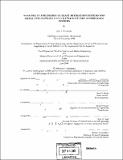Feasibility and design of blast mitigation systems for naval applications using water mist fire suppression systems
Author(s)
Kitchenka, Julie A
DownloadFull printable version (7.118Mb)
Other Contributors
Massachusetts Institute of Technology. Dept. of Civil and Environmental Engineering.
Advisor
David V. Burke.
Terms of use
Metadata
Show full item recordAbstract
The recent trend of using fine water mist systems to replace the legacy HALON- 1301 fire suppression systems warrants further study into other applications of the water mist systems. Preliminary research and investigation indicates that fine mists (20-25 pm droplet size) may reduce peak overpressures of a shock wave traveling through a space. Such pressure reductions could be used to mitigate the destructive effects of a shock wave (initiated by an explosive device) traveling through a structure. Currently these blast mitigation effects have only been demonstrated in small-scale shock tube tests and computer simulations. Uncertainty exists as to the scalability of such a system. The intention of this research is to investigate the applicability of such a blast mitigation system for shipboard use. Study into the degree of mitigation necessary to make a system practical for shipboard installation was conducted. In addition, a theoretical study of the mechanisms of blast mitigation using water mists was completed. Preliminary design of a full-scale system was examined. (cont.) Given the recent trend toward tumblehome hull forms in future Naval Combatant designs, there exists strong applicability of this system in the "dead" spaces created by the shaping of the tumblehome hull. Further work is needed in numerical modeling and laboratory testing of specific phases of the mitigation. The end goal is a feasible design of a blast mitigation system to be used in the outermost spaces of Naval Combatants to protect interior vital system spaces.
Description
Thesis (Nav. E.)--Massachusetts Institute of Technology, Dept. of Ocean Engineering; and, (S.M.)--Massachusetts Institute of Technology, Dept. of Civil and Environmental Engineering, 2004. Includes bibliographical references (leaves 73-76).
Date issued
2004Department
Massachusetts Institute of Technology. Department of Civil and Environmental Engineering; Massachusetts Institute of Technology. Department of Ocean EngineeringPublisher
Massachusetts Institute of Technology
Keywords
Ocean Engineering., Civil and Environmental Engineering.